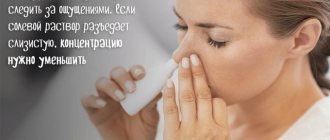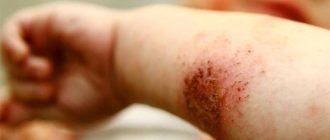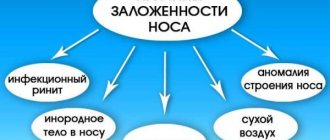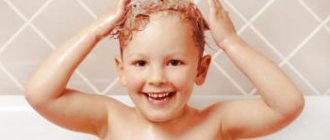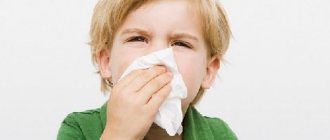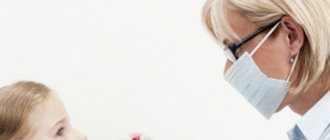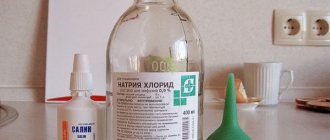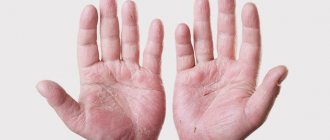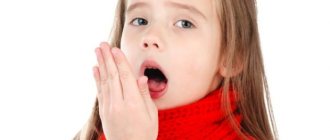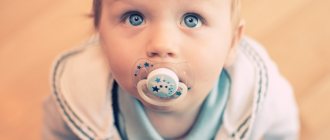- Why rinse your nose?
- Types of saline solutions. How to choose?
- What nasal rinses are suitable for young children?
- Rules for rinsing the nose of children at home
- Why do you need the Breathe® patch after rinsing?
Rinsing the nose is, at first glance, a simple and accessible procedure for everyone. But when it comes to the fact that a child needs to rinse his nose, parents have many questions. Which solution should I choose? How often should you rinse your nose? How to properly rinse a child? Are there any prohibitions and restrictions on nasal rinsing? Here are the answers to the most common questions.
Why rinse your nose?
Rinsing the nasal cavity mechanically cleanses and moisturizes the mucous membrane, repeatedly dilutes bacteria, viruses, and allergens that have entered the respiratory tract and removes them out. In addition, rinsing massages the tissues of the nasal mucosa and tonsils, improving their blood supply. Therefore, nasal rinsing is used for two main purposes:
- Prevention of ARVI infection - nasal rinsing is carried out daily during the “cold season” after returning from the street, before going to bed, after contact with a person with ARVI symptoms (cough, runny nose, red eyes).
- Fighting a runny nose and stuffy nose - nasal rinsing should be done every 4 hours.
Benefits of the procedure
Rinsing with a salt solution is recommended in many situations:
- cleaning the cavity from dust, mucus, pollen;
- disinfection;
- increasing local immunity;
- Relieving swelling, improving breathing.
Helps maintain hydration of the mucous membranes, especially if the air in the room is dry. For allergy sufferers, this procedure will help get rid of dust particles and pollen in the nose upon arrival from the street. The procedure is indicated even for healthy children to prevent viral diseases.
Types of saline solutions. How to choose?
To cleanse the nasal mucosa, saline solutions are most often used. Depending on the salt concentration, they are hypotonic, isotonic and hypertonic. What is the difference? When should which solution be used?
- A hypotonic solution
is one in which the concentration of salt in the water is lower than in human cells. Hypotonic solutions are suitable for the prevention of acute respiratory viral infections; they are also optimal for caring for the nasal cavity of infants. Such solutions are recommended for use in cases of irritation of the nasal mucosa after a prolonged runny nose, viral infections, surgical interventions, and the use of vasoconstrictors.
- Isotonic solutions
have the same concentration as in the cells of the body, about 0.9%. Isotonic saline solutions must be used in the treatment of a runny nose (infectious rhinitis), in the presence of a subatrophic and atrophic process in the mucous membrane: after operations, with nasal injuries, with prolonged inhalation of dry air.
- Hypertonic saline solutions
contain more salts than are found in the body's cells, causing them to draw water out of the cells. They stimulate local blood circulation, so they are prescribed for vasomotor rhinitis and at the first stage of short-course therapy for atrophic rhinitis (then isotonic solutions come into play).
Important!
Children can only use rinsing solutions without a strong odor or irritating effect. Saline solutions can be prepared at home, but it is preferable to use pharmacy ones, since not everyone has the necessary equipment and components at home to prepare a nasal rinsing solution of precisely calculated concentration. In addition, regular table salt often contains impurities.
What solutions can be used?
Having learned how to rinse the nose of an infant, you need to figure out what solutions can be used for this. Of course, for such tiny children, only delicate remedies are acceptable that will not worsen their well-being and will not aggravate the symptoms of the disease. You should definitely consult a doctor who will explain not only how to rinse your baby’s nose, but also how often it should be done. Both are usually due to the characteristics of the disease.
Most often, pharmaceutical preparations are used for such procedures. Many manufacturers create special versions of medications for children, and some of them can be used to treat infants. Such drugs as Humer, Marmaris, Otrivin, Aqua-Maris, etc. are suitable for these purposes. With their help, it is possible to quickly eliminate the unfavorable symptoms of the disease and stop its further development. The use of saline solution is also very common. It is effective, and at the same time does not harm the body of even a very small child.
It is also effective to use herbal infusions. They are distinguished by their gentle effect and also have various healing properties. For this age, infusions of sage, chamomile or calendula are suitable. However, an allergic reaction to herbs is possible, so you should not use this remedy yourself, without the instructions of a doctor. If after the procedures signs of an allergic reaction are found, you should immediately inform a specialist and refuse such therapy.
Often parents doubt the advisability of rinsing for babies. Their doubts are understandable. Children react negatively to such actions, it is difficult to do rinsing, and their effectiveness is significantly lower than that of systemic drugs. But it should be understood that the use of strong drugs at this age carries even more danger.
Therefore, if drug therapy can be avoided, doctors try to do this, which is why they prescribe such measures. Therefore, you should not refuse to carry out the procedure, because the result will be relief of the child’s condition.
It is better to master the rules for carrying out such procedures so as not to harm your baby. It is necessary to strictly follow the specialist’s instructions and be very careful. The body of children at this age is incredibly fragile, but they still have to be treated.
Source
What nasal rinses are suitable for young children?
- For children from infancy to 1 year of age,
only a hypotonic saline solution is used, and exclusively in the form of drops. To carry out the procedure, you must use an aspirator. - Children from 1 to 3 years old
wash their nose with isotonic saline solutions. You can use rinsing products that contain the words “shower” or “spray” in their names, with specially designed nozzles that prevent deep penetration of the water jet into the respiratory tract. - For children from 3 to 7 years old,
isotonic solutions should also be used predominantly. Only with pronounced swelling of the mucous membrane and viscous, thick discharge can hypertonic solutions be used.
Important!
If a child is prescribed vasoconstrictor drops, they can cause dystrophic changes in the nasal mucosa. To prevent this phenomenon, experts recommend rinsing the nose with solutions containing dexpanthenol. This derivative of pantothenic acid is a water-soluble vitamin B5. Dexpanthenol stimulates the regeneration of the mucous membrane, normalizes cellular metabolism, and has a regenerative and weak anti-inflammatory effect.
Basic medications for rinsing the baby's nose
You need to understand that rinsing a newborn’s nasal cavities means instilling a special agent into them. Children's medications include:
Otrivin
Nasal drops or spray. The active ingredient is xylometazoline. Constricts blood vessels, due to which mucus leaves faster and breathing improves. The medicine is used for colds and allergic rhinitis. Otrivin should be instilled into the baby's nose 2 times a day, one drop at a time, in some cases 2 drops into each nasal passage.
The course of treatment is several days, but not longer than a week. This drug can be used from the first days of the baby’s life; there are no contraindications to this. Prolonged and improper use can cause side effects in the form of increased symptoms of the disease. In some cases, tachycardia and other disorders of the cardiovascular system are possible.
Rules for rinsing the nose of children at home
1. Clear your nose of mucus.
Older children can blow their nose; children can use a bulb or aspirator. If your nose is very clogged, you may need to use a vasoconstrictor. 2. Introduce the washing liquid into one nostril using a pipette, balloon or other device, according to the instructions for it.
- If you use a balloon form, then the child’s head should be tilted forward slightly so that the chin makes a straight or acute angle with the horizon.
- The child should hold his breath while the fluid is administered. You cannot take a breath during the procedure, talk, much less scream or cry. If these rules are violated, the lavage fluid may enter the auditory tube and lead to otitis media.
- If the child is crying, you should not rinse your nose.
3. Remove the washing liquid using an aspirator by tilting the child's head or asking him to blow his nose.
Important!
You can often find rinsing schemes where liquid is injected into one nostril and forced to flow out of the other. This nasal rinsing option is more suitable for adults. It is impossible to do it with small children, and it can scare slightly older children.
4. Repeat the procedure with the other nostril.
5. Repeat rinsing after 4 hours.
6. For a child over two years old, you can stick the Dyshi® patch on your clothes to prolong the effect of free breathing after washing. In this case, you can rinse your nose less often, every 6-8 hours.
Reviews from parents
Of course, if a mother tried some remedy and it helped her child, then she most likely will not experiment with other options, but will continue to use only this drug in the future. Therefore, parents' opinions are quite subjective. Using the example of reviews from the website irecommend.ru about nasal rinsing preparations, let’s consider which drug is more preferred: saline solution, Aqua Maris Children’s drops or Aqualor Baby spray.
Parents generally give preference to saline solution; it received the highest possible score of 5 points . Advantages:
- can be used from birth;
- you can prepare it yourself (shelf life will be limited to 7–10 days);
- can be used for any type of runny nose: allergic, physiological, viral.
Every mother always has a choice: buy saline solution or its equivalent. I chose saline solution for myself and use only it. Franceva
Saline solution does not cause side effects. This is an excellent product for nasal rinsing and inhalation. romashka89
Aqualor baby spray, a remedy for the common cold, was given an overall rating of 4.6 out of 5 points . The drug is made on the basis of a solution of sea salt with various additives. The medicine is more expensive than saline, but no less effective, according to parents' reviews.
Aqualor baby spray is made on the basis of natural sea water. The drug is safe, makes breathing easier, is suitable for both treatment and prevention, and is also used from the first days of life to effectively clean the nose. Lily_Look
The product quickly relieves swelling (not as quickly as special drops, of course, you need to rinse your nose more often, but it is absolutely safe), and makes breathing easier. A runny nose goes away faster. shooik
The disadvantages include the high cost and inconvenience of use, since after releasing the spray button, the spray continues to spray for a couple of seconds.
Why do you need the Breathe® patch after rinsing?
The Breathe® patch contains essential oils with antiviral and antibacterial effects and levomenthol (extracted from essential peppermint oil).
Thanks to this composition, the patch destroys the cause of the runny nose. In addition, levomenthol and other essential oils reduce the amount of nasal discharge and make breathing easier. If you use the Breathe® inhaler patch, this will allow you to rinse your nose less often, which is important for children who do not respond well to this useful procedure. THIS IS NOT AN ADVERTISING. THE MATERIAL WAS PREPARED WITH THE PARTICIPATION OF EXPERTS.
How to clear a child's stuffy nose?
Relieving nasal congestion will make it much easier for your baby to breathe, eat and sleep.
To do this, use a rubber syringe, which is usually found in the so-called postpartum kit (baby box) and does an excellent job. You can also buy a nasal aspirator, a more modern device for sucking mucus out of the nose. Just type “nasal aspirator” into the search bar of your browser and see which of the proposed options suits you best.
If you need to clear your spout right away, use a saline solution to moisten and loosen the mucus before trying to suction it out. To do this, place the child on a flat surface, slightly lifting his chin, and put one or two drops into each nostril using a pipette (or do 1-2 sprays if you have a spray), then try to hold the baby's head still for 10 seconds .
This should ease the congestion. However, if after a few minutes your baby's nose is still clogged, you can use an aspirator.
On a note:
You can buy the solution at the pharmacy or make it yourself by dissolving 1/4 teaspoon of salt in 230 ml of warm water (if you use tap or well water, it is recommended to boil it first to sterilize it). Prepare a fresh solution every day and store in a clean, sealed glass jar.
